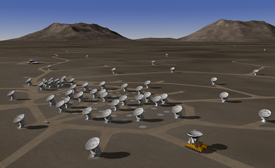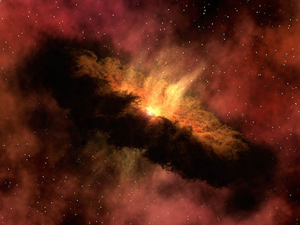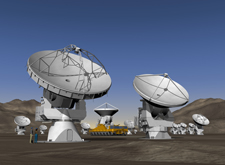66 new telescopes to explore first solar systems and the primordial universe
How do clouds of dust and gas surrounding newly formed stars become planets? – and how far back can you trace the building blocks of life? This is what Danish astronomers will be researching using the big new astronomical telescopes, Atacama Large Millimeter Array (ALMA), which has just been completed in Chile and is now beginning observations. Danish researchers from the Niels Bohr Institute are involved right from the start.
 The large, new astronomical telescope, Atacama Large Millimeter Array, ALMA consists of 66 radio telescopes and is the largest and most ambitious ground-based telescope to date. It has just been completed in Chile and is now beginning observations.
The large, new astronomical telescope, Atacama Large Millimeter Array, ALMA consists of 66 radio telescopes and is the largest and most ambitious ground-based telescope to date. It has just been completed in Chile and is now beginning observations. ALMA consists of 66 radio telescopes and is the largest and most ambitious ground-based telescope to date. Though they are called radio telescopes it does not mean that they listen for sound – they observe radio waves, which are long wavelength electromagnetic radiation. That is to say light which is outside the visible spectrum. Long wavelength radiation is important in order to observe particular phenomena in the universe.
“Rotating around young, newly formed stars are discs of dust and gas, which collect together and form planets. We would like to study these clouds of gas and dust in order to find out how planets begin to form. But the dust we are trying to measure has the effect that it absorbs the visible light from the star and instead emits this light as radiation with longer wavelengths. The dust and gas near to the star, where planets are likely to be formed, is therefore hidden from even the large optical and near-infrared telescopes like the Hubble Space Telescope and the European Very Large Telescope in Chile. So in order to study the dust, we need to observe the long-wave radiation and we can do this with the new ALMA telescopes”, explains astrophysicist Jes Jørgensen, who heads his own research group at the Center for Star and Planet Formation at the Niels Bohr Institute.
 Rotating around young, newly formed stars are discs of dust and gas, which collect together and form planets. Danish researchers want to study these gas and dust clouds in order to find out when planets began to be formed. But the dust absorbs the visible light from the star and instead emits this light as radiation with longer wavelengths and it is possible to measure this in detail with the new ALMA telescopes.
Rotating around young, newly formed stars are discs of dust and gas, which collect together and form planets. Danish researchers want to study these gas and dust clouds in order to find out when planets began to be formed. But the dust absorbs the visible light from the star and instead emits this light as radiation with longer wavelengths and it is possible to measure this in detail with the new ALMA telescopes.
Fierce competition
Along with 950 other research groups, he has applied for observation time at the ALMA telescopes, built by a worldwide collaboration between Europe, the US, Canada, Japan, Taiwan and Chile. There was fierce competition to get observing time. Approximately 30 European projects have had their research projects approved and have been allocated observation time and Jes Jørgensen’s research project is one of them.
New planets and first signs of life
"It is fantastic that we have received observation time on this groundbreaking new telescope. This means that we can be involved from the very beginning”, says a very happy Jes Jørgensen. He studies the origins of solar systems like our own and he explains that with the new telescopes, which are extremely sensitive, it will be possible to zoom in and study the fine details of the structure of the dense gas and dust clouds around the very young stars.
In addition to studying the physical properties of the dust clouds and determining whether they are in the process of clumping together and form planets, they will also study their chemical structure. From the exact chemical composition of the gas they can find answers to how and when water and organic molecules, the first basic building blocks on the path to life, formed.
 ALMA consists of 66 radio telescopes. Though they are called radio telescopes it does not mean that they listen for sound – they observe radio waves, which are long-wave electromagnetic radiation. That is to say light which is outside the visible spectrum. Long wavelength radiation is important in order to observe particular phenomena in the universe.
ALMA consists of 66 radio telescopes. Though they are called radio telescopes it does not mean that they listen for sound – they observe radio waves, which are long-wave electromagnetic radiation. That is to say light which is outside the visible spectrum. Long wavelength radiation is important in order to observe particular phenomena in the universe.
Primordial galaxies in the early universe
Astrophysicist Thomas Greve at Dark Cosmology Centre at the Niels Bohr Institute also received observation time on the ALMA telescopes. The aim of this project is to study the formation of the first galaxies in the distant universe – equivalent to a period when the universe was only med 20% of its current age. Not only are these ‘primordial galaxies’ extremely far away, but they also contain huge quantities of gas and dust between the stars, which prevents the starlight from these galaxies from reaching us.
The very early galaxies are so far away and so faint that they are usually difficult to see, but if the situation is such that the visible line between the primordial universe and Earth is located in a galaxy cluster, the gravitational pull from the thousands of galaxies in the galaxy cluster deflects and focuses the light from the primordial galaxy, which strongly amplifies it. This is called the gravitational lens effect and acts like a cosmic magnifying glass.
"Because of this lens effect we will not only be able to study these very young galaxies at extremely high spatial detail, corresponding to scales the size of a large molecular cloud in our own Milky Way, but we will also be able to detect ‘exotic’ molecules, such as water, - it is extremely exciting, and ALMA marks a revolution for these kinds of studies.”, explains Thomas Greve. The result of the research project will be a much better understanding of how the biggest galaxies formed and evolved, how effectively they formed stars, and how quickly their gas was enriched with dust and ‘complex’ molecules. These primordial galaxies are the forefathers of the enormous elliptical galaxies that we see in our immediate universe. So it is a journey of discovery through the history of the universe.
